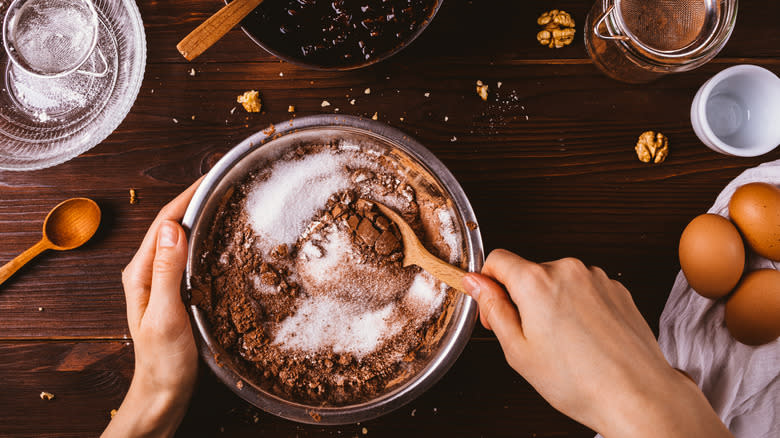Why The Order In Which You Mix Baking Ingredients Is Important

You just baked a cake and expect a perfect, fluffy, soft outcome. However, you find yourself disappointed. Out of the oven, a cake with an uneven rise, a dense bottom layer, and a texture that doesn't feel right greets you. As you retrace all your baking steps, a realization dawns: perhaps how you mixed your ingredients played a role! And you're right. Here's why the order in which you mix baking ingredients is important.
Baking involves chemical reactions and is based on food science. The raw ingredients each play a role. For instance, eggs are binders that connect your wet and dry ingredients. Milk and water help flour expand. Every ingredient in your baking mix reacts with each other and the heat of your oven to expand, rise, and transform from uncooked batter or dough to a delicious baked treat.
When baking, a good rule of thumb to follow is to prepare all your ingredients. First, mix most of your dry ingredients together, such as your flour, cocoa or matcha powder, and chemical leavening agents like baking soda, baker's ammonia, cornstarch, and baking powder, in a bowl and set it aside until it's ready for use. And when a recipe calls for creaming butter, it's best to cream softened butter first with sugar. Then add in your eggs and liquids, like milk and extracts, and finally, the bowl of dry ingredients.
Read more: The 20 Best Olive Oils For Cooking
There Is A Method To This Baking Madness

Creaming softened butter with sugar helps evenly distribute all the sugar, and whip and trap air into the butter mixture. This helps add to the lightness and fluffiness of your cakes. Adding and mixing in your emulsifiers, such as eggs, and the rest of the wet ingredients next will help bind the batter or dough with the dry ingredients you introduce.
Finally, incorporating the premixed dry ingredients, as aforementioned, ensures uniformity. By thoroughly mixing these dry components beforehand, you prevent clumping and ensure that leavening agents are evenly distributed, which is crucial for a uniformly risen cake with an even texture.
So, the next time you dive into baking, remember how the order in which you mix baking ingredients matters. It's about creating harmony among different components and letting each ingredient play the role it's meant to play. Each step, from creaming butter and sugar to adding eggs and liquids and finally incorporating dry ingredients, is designed to achieve a specific purpose. This methodical approach guarantees there will be perfect cakes and cookies in the oven for you every time.
Read the original article on Tasting Table.